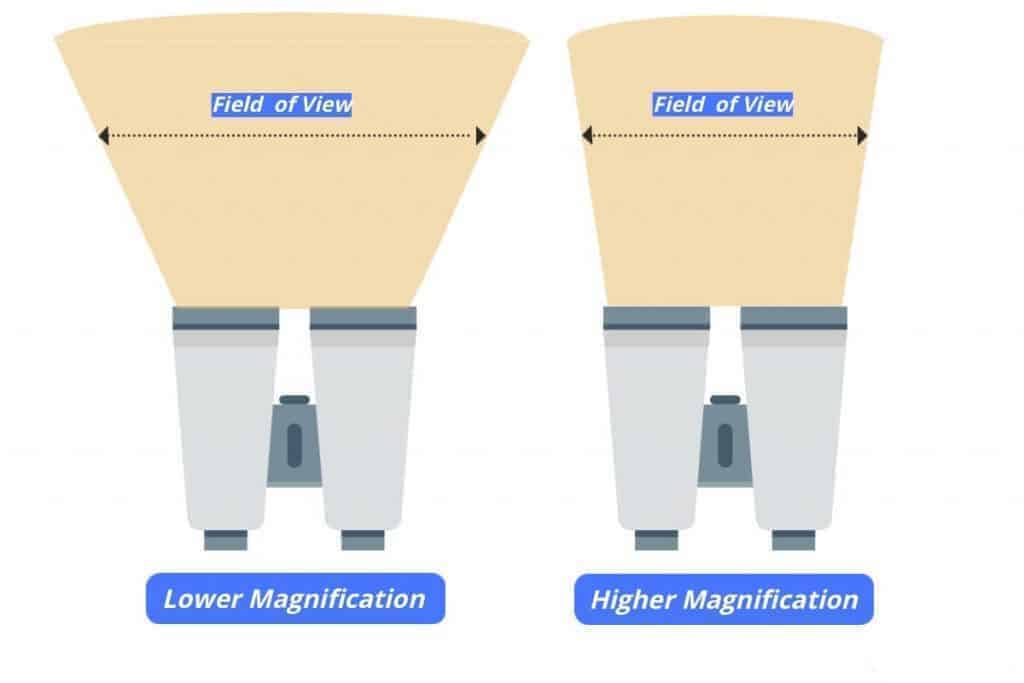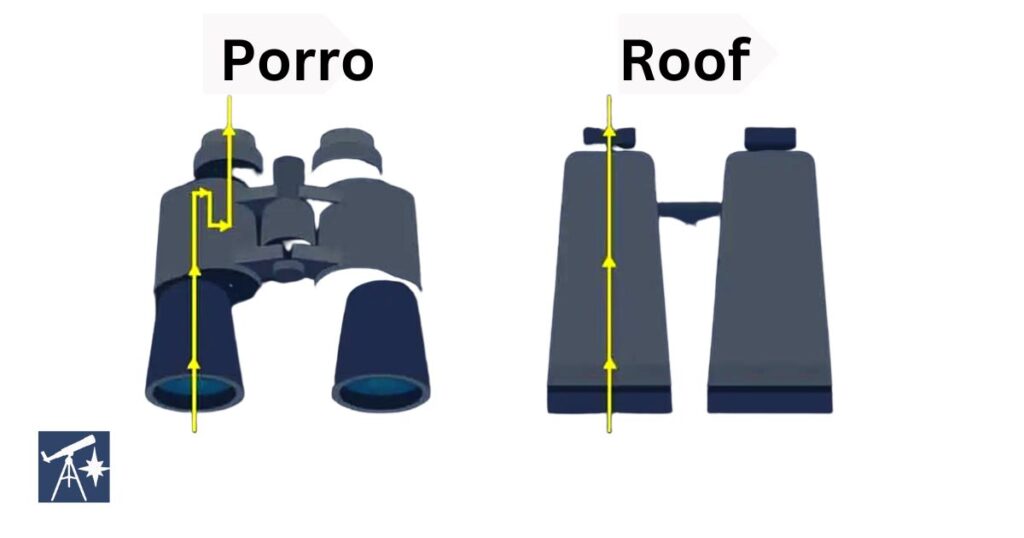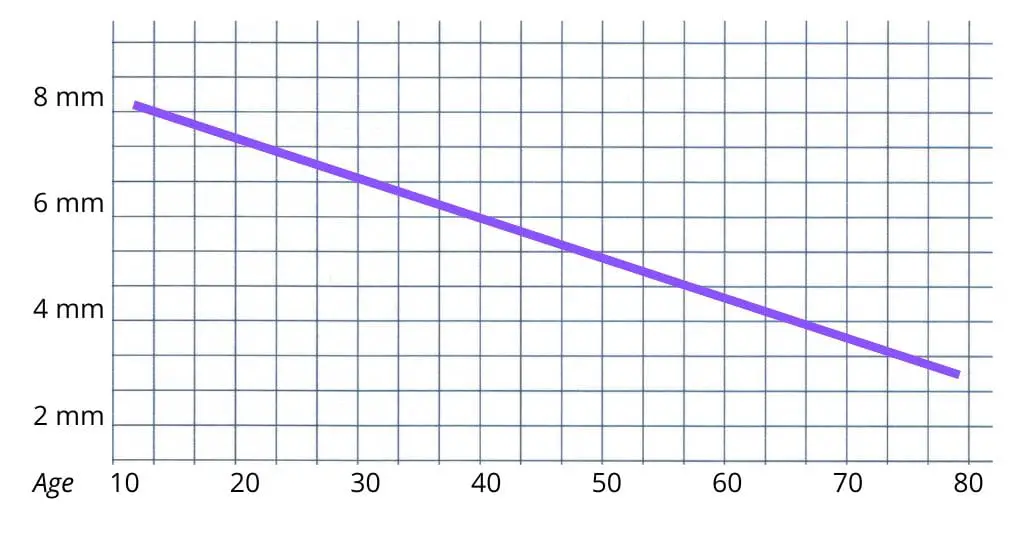Astronomy binoculars are a great way to explore the cosmos from your own backyard or a dark-sky location. Finding the perfect pair can be overwhelming now that so many options are available. Here, I take you through some key features to consider when choosing astronomy binoculars…

What to know when buying astronomy binoculars
Looking through lists of binoculars for sale can be overwhelming.
Certainly, there are a few things to ponder if you want the best stargazing binoculars right for you, especially for the beginner…let’s start with the numbers.
Binocular size
What do the numbers mean for binoculars?
These numbers represent the magnification power and the diameter of the objective lenses, respectively. As an example, let’s take the 7×50.
The smaller number, 7, represents the magnification power and the larger number, 50, is the optical diameter (mm) of the lenses in the binoculars.

Let’s look at the smaller number first.
Magnification power (smaller number)
What is the best magnification power for stargazing binoculars? If you are wanting to buy binoculars for astronomy, a power of 7× is okay and an economical start.
Compared to the ultimate claimed in magnification is 20×. Having said that, holding any above 10×, astronomy-wise be difficult to keep steady.
By the same token, a 7× magnification can be just as problematic to keep steady. You will need to use a tripod or other methods (see binoculars best ways to steady them below) to stop the shaking and get a clear view.
Field of view
Expect a reduced field of view with higher magnification. Although, you’ll get a closer view and more details in the image, going larger in power will sacrifice your field of view.

For example…the 8x option by Nikon, shown further below, has a 8.3º FOV while the 10x option by Orion, shown above, 6.5º and the 15x by Canon, 4.5º.
Optical diameter (larger number)
The diameter of the front lenses determines the amount of light you receive through the binoculars. Simply put, the larger the lens the more light gets captured and presented and the brighter the image.
A 35 mm diameter in binoculars for astronomy is a starting point in binoculars for astronomy beginners or hobbyists. A 50 mm will give you better light-gathering ability for astronomical use.
More aperture is useful for astronomy. You’ll see fainter stars (lower visible brightness) with a 10×80, for example, than a 10×50. But, the larger the aperture, the bigger and bulkier are the binoculars and this means it’s harder to keep them steady.
You can use a tripod to help with this (I talk about this further down the page). Keep reading though, there are other factors that you need to consider regarding the objective size, e.g., exit pupil.
Prisms — Porro Vs Roof
One of the most important choices binocular makers have is what type of prism to use…They affect a pile of different things, not just the image brightness and sharpness, but also the weight, balance or length of the binocular.
Bill Stent, enthusiast in bird watching
The two types of prisms used in binoculars are the roof (Dach) prisms and Porro prisms. Porro prisms are used in astronomy types. The glass in these prisms can vary in quality. I wrote about this in my article comparing BAK-4 to BK-7.

Porro prisms yield a bent path of light, shaped like a Z. Binoculars with these prisms tend to give brighter images than the roof prism type, even with the same objective size, magnification, and optical quality.
The view through roof prism binoculars is straight through as the lenses and eyepieces are aligned rather than offset. These types are narrow and more compact.
On the downside, the offset nature of the lenses and the eyepieces in the Porro-prism binoculars (see above image) make them bulkier to carry and fit in places. And they aren’t the easiest to waterproof.
Optics — the glass
The best binoculars have optics that hold the focus out to the edge of the field of view when focusing on an object in the center of that field. Such a design overcomes or limits the dispersion of light as it passes through the front lens.
To attain such, makers treat the optics with elements that reduce dispersion and diminish aberrations. This treated glass has various descriptions that include UD (ultra-low dispersion), ED (extra-low dispersion), LD (low dispersion), SLD (special low dispersion), and ELD (extraordinary low dispersion).
Such properties reduce chromatic aberration, or color fringing, to give the best image.
It doesn’t have to be perfect — but what you don’t want are optics where the edge is way out of focus or highly distorted.
Coatings
In modern binoculars, performance in low light conditions, such as twilight, can depend on the quality of the optical coatings.
Anti-reflective (AR) coatings work to reduce the amount of light being lost through reflection. In binoculars without AR coating, you can lose up to 5% of light-transmitted in binoculars. So the AR coating helps improve light transmission through the binoculars.
Modern lenses are coated with complex multi-layers of anti-reflective material.
To look for an anti-reflective coating, pick them up and look at the light reflected in the lenses. According to experienced users, a good AR coating would mean the lenses are dark but with some reflected color. Avoid ones where the lenses appear white or ruby red. A white surface indicates no AR coating and ruby-red is a highly reflective coating that limits brightness.
Complexity of AR Coatings
There are different types of AR coatings and manufacturers generally describe these as either fully multi, fully, multi, or coating.
- Fully multi-coated: Generally means multiple layers of coating on all lens surfaces. Fully multi is found on high-end optics.
- Fully coated: Has a thin AR coating on both sides of both the objective lens and the ocular lens systems, as well as the length of the prism.
Multi-coated indicates there are multiple layers of coating, but not necessarily on all lens systems.
And, coating suggests a single coating only, usually of magnesium fluorite.
Exit Pupil
The exit pupil is the round frame of light seen emerging from the binocular eyepieces. The larger it is, the brighter the image that reaches your eye.
To calculate the exit pupil of binoculars, divide the objective diameter (larger number) by the magnification (smaller number). A set of 10×50 (objective diameter of 50 mm and a magnification of 10) will have an exit pupil of 5 mm. A set of 7×50 will have an exit pupil of about 7.
Under low light, you’ll get a brighter and fuller image through a device that has an exit pupil no larger than the entrance pupils of your dark-adapted eyes.

If your pupil only opens to 5 mm under night conditions and the object has an exit pupil of 7 mm, then the extra 2 mm is wasted, according to experts.
If the exit pupil of the instrument is larger than your entrance pupil, you waste light.
Robert Bruce Thompso & Barbara Fritchman Thompson in Astronomy Hacks
The average dilated pupil diameter for someone 30 years or under is 7 mm. At about 50 years or older you’re looking at a dilated pupil diameter of between about 5 and 6 mm. This is because as you age, your pupils lose the ability to dilate as much.
- Under 30 yrs ~ mean 7 mm dilated pupil diameter (7×50 is good)
- 50 yrs and above ~ 5–6 mm dilated pupil diameter (7×35 or 7×42, or 10×50 is better)

The above is a general trend.
Eye Relief
This is about comfort and seeing the entire field of view and can make a difference for holding the binoculars steady.
If you need to wear glasses, look for a minimum of about 16 mm or more. Naturally, it will depend on you and your glasses.
Eye relief length is especially important if you wear glasses for astigmatism. You don’t need to wear glasses if you are near- or farsighted since you can adjust the focus of the binoculars to account for these sight issues.
Eye relief of binoculars is usually between a few millimeters and a few centimeters. When wearing glasses, the longer the eye relief, the better the fit for comfort and the better will be your ability to see the entire field of view.
Other
Tripod ready
Does it have a tripod adapter hole? Look for a threaded hole in the front of the central bar. This will allow you to mount it on a camera tripod and keep the binoculars steady while viewing.
Zoom or Built In Camera
According to experienced users, a built in camera or zoom doesn’t make the grade if you want a pair of binoculars for astronomy. If you do have one, then the recommendation is to set it on low. You can use it to zoom in when observing the Moon.
Changeable Eyepieces
Some astronomical binoculars have changeable eyepieces that change the magnification.
Waterproof
Waterproofing is something to consider if the weather and moisture are a concern for you and you don’t mind paying that bit more.
Recommendations: binoculars for astronomy
At the higher end, astronomy writer, Terence Dickinson mentions two best binoculars for astronomy in his practical guide, NightWatch #ad (btw, a great resource for the beginner).
Canon 15×50 IS
Dickinson depicts the Canon 15×50 IS as the very best binoculars he’s used.
The image stabilization (IS) technology in the Canon 15×50 (shown) overrides the handheld shaking problem with binoculars of this size so you can effectively hold them up to the sky to use for astronomy.
They have a super-sharp 4.5º field of view and are all-weather. Also, has a 15mm long-eye relief and features UD (ultra-low dispersion) optics.

All weather binoculars
Available at Amazon (affiliate link)
The downside of these is they are large and weigh in at 2.6 lb. And, you might want to fold the eyecups down if they become annoying. They do come with a price tag around the thousand mark.
Nikon 8×42 HG
Also recommended by Dickinson is the Nikon 8×42, which he calls ‘superb“. It has a roof prism and features ED (Extra-low Dispersion) glass as well as the following.
- Exit pupil 5.3mm
- Eye relief 17.8 mm
- Fog-proof and waterproof
- FOV 8.3°

Nikon Monarchs
available at Amazon (affiliate link)
Cheaper astronomy binoculars
For astronomy binoculars, Amazon has a range to choose from including some popular brand names. Among these are Nikon, Orion, and Celestron. Here are two Celestron binoculars for skywatching in the lower price range.
Cometron 7×50 Celestron Binoculars

Large 50mm objective lenses
available at Amazon (affiliate link)
This Celestron set is water resistant, which is what you need for outdoor use, especially at night when you are likely to experience dew or mist.
With a 50 mm objective lens, the field of view is 357 feet at 1000 yards. The lenses are multicoated with a large exit pupil (7 mm). The distance between the centers of the pupils (IPD) is 56–72 mm and the close focus distance, which is the closest point that the binocular can focus on, is 26.2 ft. Eye relief is 13 mm with a folding eyecup.
Housing is aluminum. Accessories include a carrying case, objective and eyepiece covers, and lens cloth.
This is a Porro-prism binoculars set (objective lenses and eyepieces are offset). The prism material is BK-7.
This Celestron set comes at a price in the range seen for the best budget binoculars for astronomy.
Pros:
A pair of low-priced binoculars for beginners with features of a large pupil exit (best for the under 30 s), Porro-prisms, and AR coating.
Cons:
- Not optimum for those who need to wear glasses (i.e., those with astigmatism) given the eye relief of 13 mm and older users would be better with a pupil exit of 5–6 mm. Also, if you want a higher grade prism material, look further and consider paying more.
Celestron SkyMaster Giant 15×70 Binoculars

SkyMaster 15×70 (Amazon affiliate link)
The field of view is 231 feet at 1000 yards or 4.4° for these binoculars Celestron make with a 70 mm objective lens and 15 magnification.
The long eye relief and soft rubber folding eyecups make this ideal for wearers of glasses and with an exit pupil of 4.66 mm, one of the best binoculars under 100 dollars for mature astronomers.
Users have claimed that galaxies, like Andromeda, are easy to spot with these binoculars, with one noting the view of face-on spiral galaxies was better than with a 10″ telescope.
The optics are multi-coated.
This is a Porro-prism binoculars set (objective lenses and eyepieces are offset). The glass material is high index BAK-4. Close focus distance is 47.2 feet.
It comes with many accessories, like lens covers, rain guard, carrying case, neck strap, and cleaning cloth. It does not come with a tripod but can be used with a tripod.
This Celestron binoculars set is also water resistant.
Pros: Constructed with high-grade prism material, BAK-4, which is optimum, inferring better light transmission and edge-to-edge sharpness. Great for wearers of glasses given the long eye relief. Especially suited to older users with an pupil exit of 5 mm.
Cons: Doesn’t come with a tripod, though it is tripod adaptable. With an objective lens of 15, the use of a tripod is recommended.
Where to buy astronomy binoculars
- Explore Scientific
- SAVE up to $20 off on Binoculars!
at Orion Telescopes & Binoculars
- Compare prices of binoculars for astronomy (affiliate link) at Amazon

Final thoughts
A pair of binoculars has many uses in astronomy (see our list of reasons why) and make a great accompaniment to an astronomical telescope.
How to choose binoculars for exploring the night sky?
For the best binoculars for astronomy, look for these features:
- A complex anti-reflection coating
- Prism with a high-grade glass, such as BAK-4
- Low-dispersion glass
- Consider at least a 7x magnification and 50x objective lens diameter
In the end, what you buy in binoculars will depend on your budget. How much do you want to (or can afford to) spend? And, do the binoculars have the features to satisfy you for use of the binoculars astronomical wise?
Other features to consider:
- Zoom or in built camera or not (recommended to avoid)
- Exit pupil (age-related)
- Eye relief (especially if you wear glasses)
If you’re new here and starting out with astronomy, you might like to check out our Beginner’s Page where you will find helpful guides and tips to get more out of your stargazing experience.
Or, see our Buyer’s Guide Section if you are looking to buy astronomy gear and need some help sorting through the numerous options
FAQs
Can I Look At The Moon With Binoculars?
Binoculars are especially good for viewing the Moon in full detail. They have many uses in astronomy. Have a pair set up on a tripod to watch the blood moon forming during an eclipse. A view through binoculars will enhance your experience of this rare event.
Info sources
Nikon: Types of Binoculars |
Information was also gathered from owners of astronomy binoculars and binocular reviews and publications:
- The Editors of One-Minute Astronomer. 2009. Stargazing for Beginners. A Binocular Tour of the Night Sky (v1.5). Mintaka Publishing.
- English, Neil. 2014. Grab ‘n’ Go Astronomy. The Patrick Moore Practical Astronomy Series. Springer.
- Nightwatch, a Practical Guide to Viewing the Universe by Terence Dickinson (available at Amazon – affiliate). This book contains sky charts and has a spring binding and so is practical for use on location.
- Astronomy Australia Year Guide to the Night Sky (affiliate link) by Wallace, Dawes, and Northfield includes all sky maps and much more information for stargazing down under
